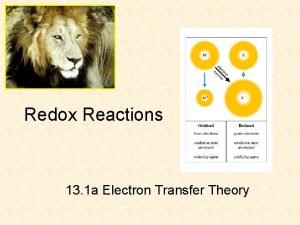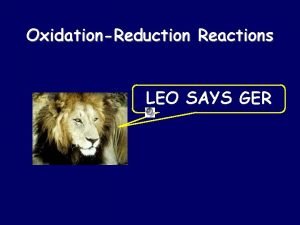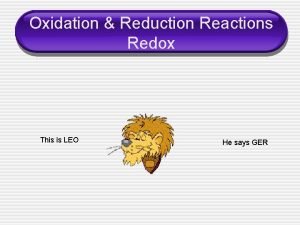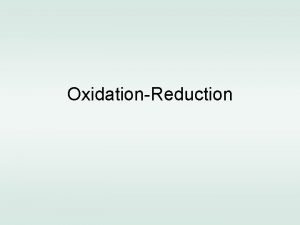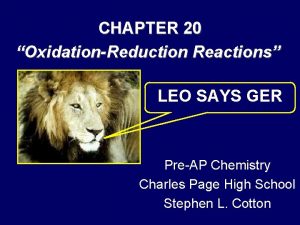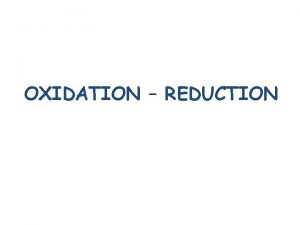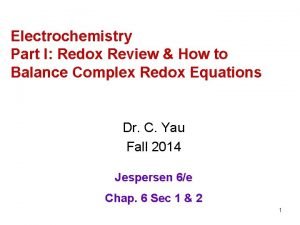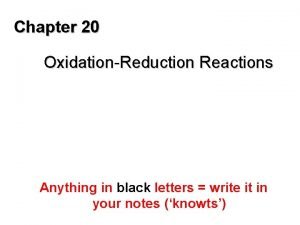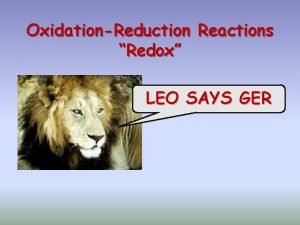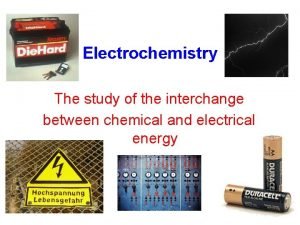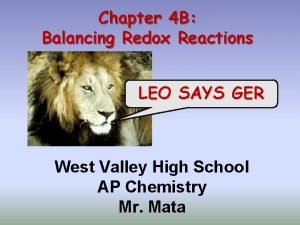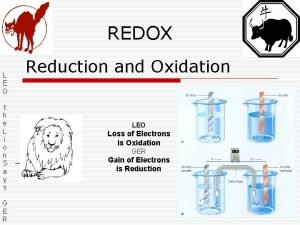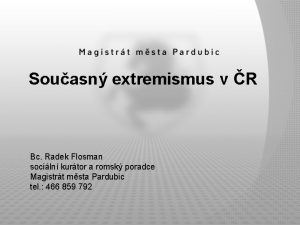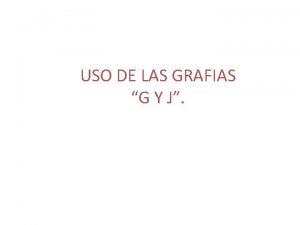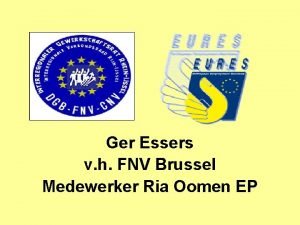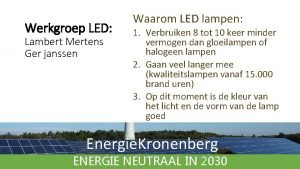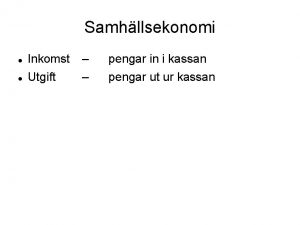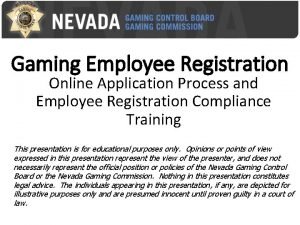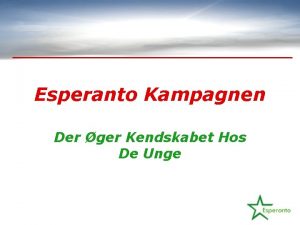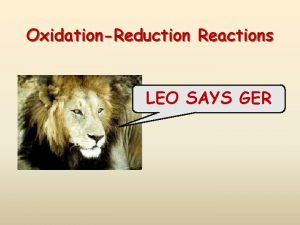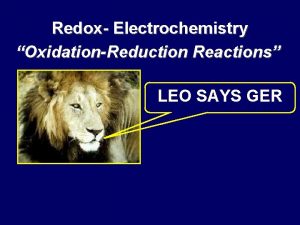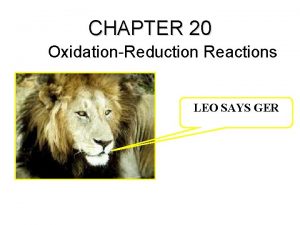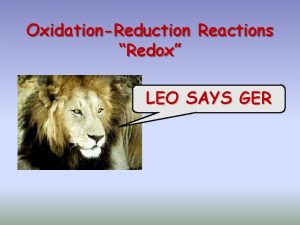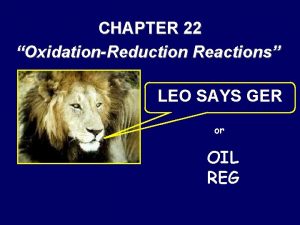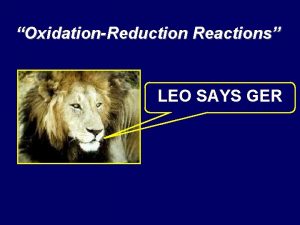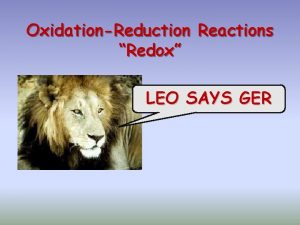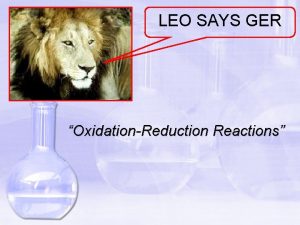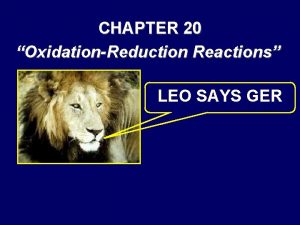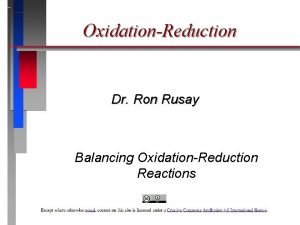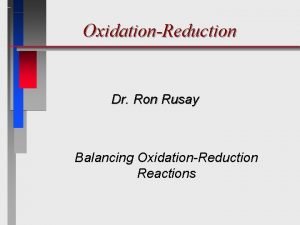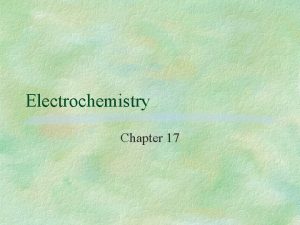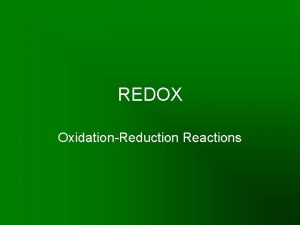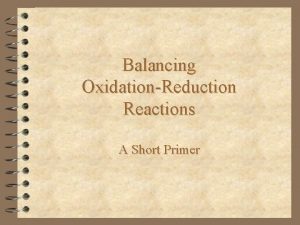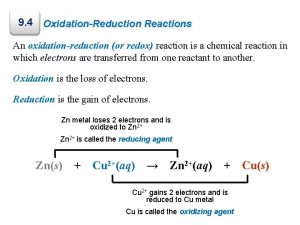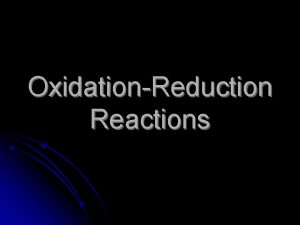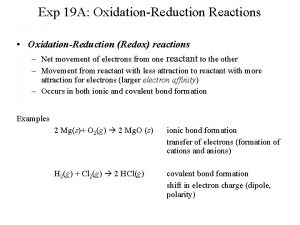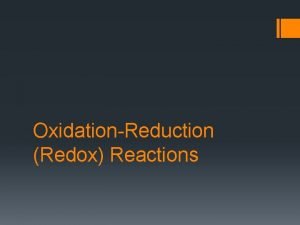OxidationReduction LEO LEO says GER GER LEO says


























- Slides: 26

Oxidation-Reduction

LEO

LEO says GER!

GER! LEO says Loss of Electrons = Oxidation Gain of Electrons = Reduction

Oxidation Numbers • Oxidation is the loss of electrons; Reduction is the gain of electrons • Oxidation and reduction go together. Whenever a substance loses electrons and another substance gains electrons • Oxidation Numbers are a system that we can use to keep track of electron transfers

Oxidation Numbers Oxidation numbers always refer to single atoms The oxidation number of an uncombined element is always 0 O 2, H 2, Ne Zn The oxidation number of Hydrogen is usually +1 Hydrides are an exception They are -1 HCl, H 2 SO 4 The oxidation number of Oxygen is H 2 O, NO 2, et usually -2 Peroxides are an exception They are – 1 In OF 2 oxygen is a +2 Oxidation numbers of monatomic ions follow the charge of the ion O 2 -, Zn 2+ The sum of oxidation numbers is zero for a neutral compound. It is the charge on a polyatomic ion Li. Mn. O 4 SO 42 -

Practice Assigning Oxidation Numbers NO 2 N 2 O 5 HCl. O 3 HNO 3 Ca(NO 3)2 KMn. O 4

Practice Assigning Oxidation Numbers Fe(OH)3 K 2 Cr 2 O 7 CO 32 CNK 3 Fe(CN)6

Practice Assigning Oxidation Numbers NO 2 N= +4, O = -2 N 2 O 5 N = +5, O = -2 HCl. O 3 H=+1, Cl=+5, O = -2 HNO 3 H=+1, N = +5, O = -2 Ca(NO 3)2 Ca=+2, N =+5, O= -2 KMn. O 4 K=+1, Mn=+7, O= -2

Practice Assigning Oxidation Numbers Fe(OH)3 Fe =+3, O=-2, H=+1 K 2 Cr 2 O 7 K=+1, Cr=+6, O=-2 CO 32 - C=+4, O =-2 CN- C=+4, N=-5 K 3 Fe(CN)6 K=+1, Fe=+3, C=+4, N=-5

Using Oxidation Numbers • Careful examination of the oxidation numbers of atoms in an equation allows us to determine what is oxidized and what is reduced in an oxidation-reduction reaction

Using Oxidation Numbers • An increase in the oxidation number indicates that an atom has lost electrons and therefore oxidized. • A decrease in the oxidation number indicates that an atom has gained electrons and therefore reduced • Example Zn + Cu. SO 4 Zn. SO 4 + Cu 0 +2 +6 -2 +2+6 -2 0 Zn: 0 + 2 Oxidized Cu: +2 0 Reduced

Exercise For each of the following reactions find the element oxidized and the element reduced Cl 2 Cu + KBr KCl + Br 2 + HNO 3 Cu(NO 3)2 + NO 2 + H 2 O HNO 3 + I 2 HIO 3 + NO 2

Exercise For each of the following reactions find the element oxidized and the element reduced Cl 2 0 + KBr +1 -1 KCl + +1 -1 Br increases from – 1 to 0 -- oxidized Cl decreases from 0 to – 1 -- Reduced K remains unchanged at +1 Br 2 0

Exercise For each of the following reactions find the element oxidized and the element reduced Cu + HNO 3 Cu(NO 3)2 + NO 2 + H 2 O 0 +1+5 -2 +2 +5 -2 +4 – 2 +1 -2 • Cu increases from 0 to +2. It is oxidized • Only part of the N in nitric acid changes from +5 to +4. It is reduced • The nitrogen that ends up in copper nitrate remains unchanged

Exercise For each of the following reactions find the element oxidized and the element reduced HNO 3 + I 2 HIO 3 + NO 2 1 +5 -2 0 +1+5 -2 +4 -2 • N is reduced from +5 to +4. It is reduced • I is increased from 0 to +5 It is oxidized • The hydrogen and oxygen remain unchanged.

Oxidation-Reduction Reactions • All oxidation reduction reactions have one element oxidized and one element reduced • Occasionally the same element may undergo both oxidation and reduction. This is known as an autooxidation reduction

Balancing Redox Reactions • Many chemical reactions involving oxidations and reductions are complex and very difficult to balance • For complicated reactions a more systematic approach is required

Balancing Redox Reactions There are several basic steps 1. Assign oxidation numbers to the species in the reaction 2. Find the substance oxidized and the substance reduced 3. Write half reactions for the oxidation and reduction 4. Balance the atoms that change in the half reaction 5. Determine the electrons transferred and balance the electrons between the half reactions 6. Combine the half reactions and balance the remaining atoms 7. Check your work. Make sure that both the atoms and charges balance

Balancing Redox Equations 1 1. Assign oxidation numbers to the species in the reaction 2. Find the substance oxidized and the substance reduced 3. Write half reactions for the oxidation and reduction 4. Balance the atoms that change in the half reaction 5. Determine the electrons transferred and balance the electrons between the half reactions 6. Combine the half reactions and balance the remaining atoms 7. Check your work. Make sure that both the atoms and charges balance Cu + HNO 3 Cu(NO 3)2 + NO + H 2 O

Balancing Redox Equations 2 1. Assign oxidation numbers to the species in the reaction 2. Find the substance oxidized and the substance reduced 3. Write half reactions for the oxidation and reduction 4. Balance the atoms that change in the half reaction 5. Determine the electrons transferred and balance the electrons between the half reactions 6. Combine the half reactions and balance the remaining atoms 7. Check your work. Make sure that both the atoms and charges balance HNO 3 + I 2 HIO 3 + NO 2 + H 2 O

Balancing Ionic Redox Equations 3 1. Assign oxidation numbers to the species in the reaction 2. Find the substance oxidized and the substance reduced 3. Write half reactions for the oxidation and reduction 4. Balance the atoms that change in the half reaction 5. Determine the electrons transferred and balance the electrons between the half reactions 6. Combine the half reactions and balance the remaining atoms. You may need to add H+ or OH- and H 2 O in ionic equations 7. Check your work. Make sure that both the atoms and charges balance Fe 2+ +Mn. O 4 - Mn 2+ +Fe 3+ (acidic)

Balancing Ionic Redox Equations 4 1. Assign oxidation numbers to the species in the reaction 2. Find the substance oxidized and the substance reduced 3. Write half reactions for the oxidation and reduction 4. Balance the atoms that change in the half reaction 5. Determine the electrons transferred and balance the electrons between the half reactions 6. Combine the half reactions and balance the remaining atoms. You may need to add H+ or OH- and H 2 O in ionic equations 7. Check your work. Make sure that both the atoms and charges balance Br 2 Br. O 3 - + Br- (basic)

Balancing Ionic Redox Equations 5 1. Assign oxidation numbers to the species in the reaction 2. Find the substance oxidized and the substance reduced 3. Write half reactions for the oxidation and reduction 4. Balance the atoms that change in the half reaction 5. Determine the electrons transferred and balance the electrons between the half reactions 6. Combine the half reactions and balance the remaining atoms. You may need to add H+ or OH- and H 2 O in ionic equations 7. Check your work. Make sure that both the atoms and charges balance VO 2+ + Zn 2+ (Acidic)


 Leo the lion says ger
Leo the lion says ger Leo says ger chemistry
Leo says ger chemistry Leo says ger
Leo says ger Oxidation number method
Oxidation number method Ger leo
Ger leo Leo says ger
Leo says ger Oxidation practice problems
Oxidation practice problems Leo the lion says ger
Leo the lion says ger Oxidation–reduction reactions
Oxidation–reduction reactions Leo ger oxidation reduction
Leo ger oxidation reduction Leo the lion says ger
Leo the lion says ger Leo says ger chemistry
Leo says ger chemistry Leo ger example
Leo ger example Reactions19
Reactions19 Leo goes ger
Leo goes ger Opfer rune
Opfer rune Grafias g
Grafias g Ger essers
Ger essers Rogier moulen janssen
Rogier moulen janssen Inkomst och utgift
Inkomst och utgift Familia léxica
Familia léxica Gcbger.nv.gov/regapp
Gcbger.nv.gov/regapp Ung ger
Ung ger Gross enrolment ratio formula
Gross enrolment ratio formula Uwm dance team
Uwm dance team Uaa ger
Uaa ger Ger construction
Ger construction
